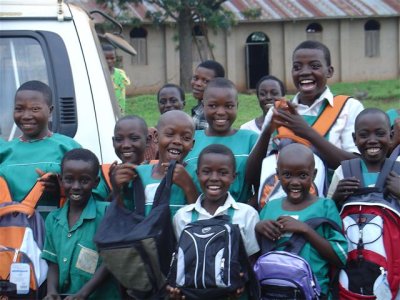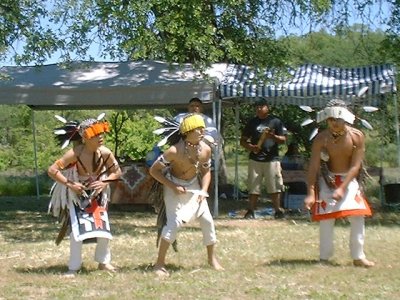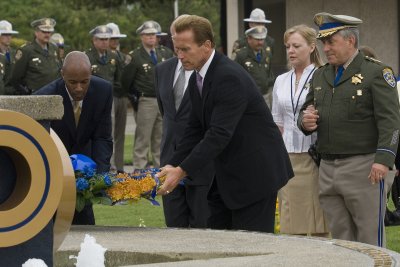
Schoolchildren from Kiyoima Primary School in Uganda welcomed Weeks and her family. Photo by Leslie Weeks.
Editor's note: This is the last of two articles by Clearlake resident Leslie Weeks on her trip to Uganda in December. Weeks, her husband, John Weeks, MD, and their daughter went to Uganda with Dr. Arthur Bikangaga, who is from Uganda.
Soon after our arrival, the electricity went off (electricity is sold to neighboring countries for a better rate, so the electric often goes off at night) and we were left sitting in a room with one candle.
The staff may have been a bit unsettled because there had been a riot at the university a week before. The teachers had demanded a raise in pay and were demonstrating. The police ended up chasing them through the campus with guns and sticks.
We went to bed and abruptly woke up at 2 a.m. because the time difference between Uganda and California is 11 hours. We had problems with sleep for about one week and during this time we were always so glad to hear the “Call to prayer” sung at the local mosque each morning at 5:45 a.m. The city was fully quiet at that hour, and this beautiful voice floating over the rooftops always seemed to make everything better.
After four days one suitcase with my daughter’s and my clothes arrived. The next day the school supplies were located, but customs would not release them unless we came to the airport in person. The claim was that we were going to sell the supplies on the street so it was necessary to pay a tax. We did not realize that this was all about bribing the customs agent.
We spent three hours counting each pencil, pen and toothbrush, handwriting a list on a piece of paper, and then waiting on a hard wooden bench. We would peer around the piles of opened boxes in front of us to see our self-important agent sitting at his table and occasionally speaking with one of his cohorts. We waited. It was very hot.
He finally signaled for us to approach his table and gave us a piece of paper after dramatically stamping it. He directed us to another fold out table where a scowling woman sat. I fearfully approached, hoping there wasn’t going to be another three-hour delay.
She held my paper in hand, the other hand hovering the stamp directly over it. This lasted about 15 minutes. She finally stamped the paper and handed it to me, told us to go get the luggage and see the lady at the door. She gave me a significant look. However, I had no idea what it meant.
We got our four suitcases and headed toward the door. There was no lady there, so we left, not paying any “taxes” after all. My husband got his suitcase with all of his clothes and our hiking gear, mosquito nets, extra medicine, etc. three days after we arrived back in Lake County. One bag of medications had somehow disappeared in that cluttered room.
After he wore the same outfit for six days, we decided we had to replace John’s clothes, which we had not anticipated financially. We realized the airlines weren’t going to be quick to find the missing clothes after a more empathetic airline representative informed us, “I guess I can understand why an American would be upset if he had to wear the same clothes for six days.”
Ugandans put a lot of importance on dressing well, or “smart,” and consider the “Mzungus” (white people) rude if under-dressed. Whenever we told Ugandans of our suitcase plight, they were always quick to say “Sorry,” which is their way of expressing sympathy.
Cash economy
We quickly learned very few places in Uganda take credit cards, and then they only take Visa. We became familiar with the two malls and various other shopping areas. We then found a Woolworth’s willing to take the credit card. With everyone freshly clothed, we were ready to continue our journey.
Six hours and one flat tire later, we arrived at the Kiyoima primary school. The reception the children and staff gave us made all the previous difficulty and discomfort insignificant.
Although school is out in December and January, children, teachers, elders from the village, and the assistant headmaster had gathered just to welcome us. The children sang two delightful songs that brought tears to my eyes. These children still only spoke their local dialect and had learned these songs in English. There are approximately 63 dialects in Uganda, but all the schools teach English.
After we shared a surprisingly delicious barbecued goat (meat is a delicacy in Uganda, vegetarians are pitied), the children led us outside where they performed their local dance. They grabbed our hands and we danced with them amidst many giggles.
We had to leave because it was getting late, so we reluctantly said goodbye to these beautiful children and their teachers. We told the teachers that we had mailed clothes for them in the beginning of December, but they hadn’t arrived yet. We told them two boxes of books would hopefully arrive in February. The assistant headmaster jumped with joy. We wished we could give them more.
We continued our safari and saw the wild beauty of Uganda. We were within yards of mountain gorillas that barely gave us a glance. When a huge silverback did look our way, there was no question of who was boss.
We searched for hours for the climbing lions in Ishasha, and eventually found the gorgeous lions languidly hanging out in fig trees. Baboons lined the dirt-rutted roads while several species of monkeys clamored overhead.
The earth was so fertile, local people had gardens on every inch of cleared space. Zebras, hippos, crocodiles and elephants were all equally stunning. Birds were brimming with grace and color. Water buffalo, impalas and wart hogs all had their own personalities.
Even as we were thrilled by the incredible and diverse wildlife, we were also impacted by the strength and individuality of each Ugandan.
Safari lesson
We left Uganda two weeks later, feeling elated, frustrated, tired, hungry, and sad to leave.
On this safari that originated in Lake County, we learned that tolerance and understanding starts with one person, and can spread to many.
Rudyard Kipling says it well in his poem, “We and They”:
Father, Mother and Me
Sister and Aunties say
All the people like us are We,
And everyone else is They.
And They live over the sea
While we live over the way,
But – would you believe it?
They look upon We
As only a sort of They!
We eat pork and beef
With cow-horn-handled knives.
They who gobble Their rice off a leaf
Are horrified out of Their lives;
While They who live up a tree,
Feast on grubs and clay,
(Isn’t is scandalous?) We look upon
As a simply disgusting They!
We eat kitcheny food.
We have doors that latch.
They drink milk or blood
Under an open thatch.
We have Doctors to fee.
They have the Wizards to pay.
And (impudent heathen!)
They look upon We
As a quite impossible They!
All good people agree,
And all good people say,
All nice people, like Us, are We
And everyone else is They:
But if you cross over the sea,
Instead of over the way,
You may end by (think of it!)
Looking on WE
As only a sort of They!
With people like Bill and Kate, Julia, wonderful giving teachers in Uganda, students in elementary schools, and generous people here in Lake County, cultural gaps can be bridged and differences can begin to be overcome on a much grander scale.
Traveling to other countries is not always easy, things we experience there are not always pleasant, or comfortable, but I hope it always brings the “They” into our “We.”
{mos_sb_discuss:2}

 How to resolve AdBlock issue?
How to resolve AdBlock issue? 












